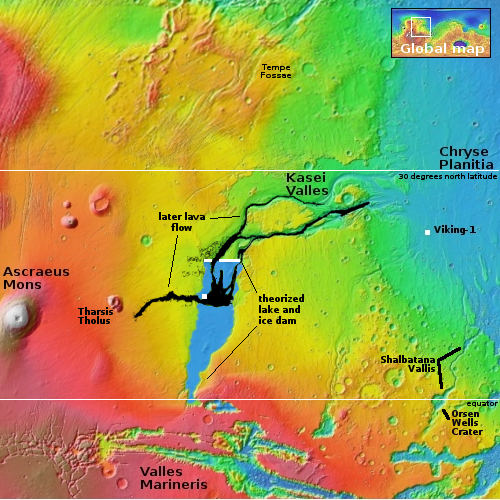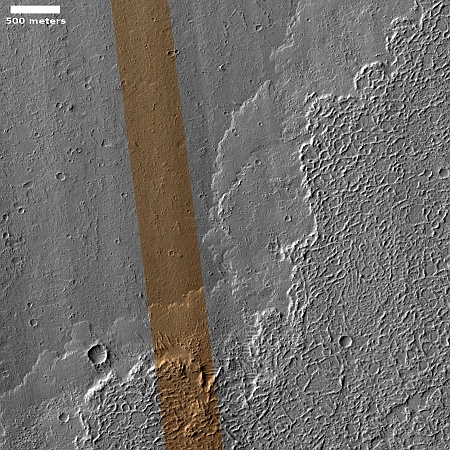Seepage coming from under an ancient Martian flood lava flow?
Cool image time! The picture to the right, cropped, reduced, and enhanced to post here, was taken on April 3, 2025 by the high resolution camera on Mars Reconnaissance Orbiter (MRO).
I have enhanced the image to make it easier to see the details. It appears we are looking at three layers. At the base (on the left side of the picture) is a relatively smooth bottom layer with the highest number of scattered craters. On the top (on the right side of the picture) is a somewhat rough layer with fewer craters.
In between is a middle layer that appears to be seeping out from under the top layer.
The science team seems to agree with my last guess, as they label this image “Possible basal seepage at flow boundary.” The flow boundary is the edge of a lava flood that scientists believe covered a distance of about 1,400 miles at speeds ranging from 10 to 45 miles per hour.

The white dot on the overview map to the right marks the location, on the very edge of that flood lava event (indicated in black) that poured out from the volcano Tharsis Tholus and quickly flooded the Kasei valley. The valley itself scientists believe was first formed by catastrophic floods of water coming from the south. One theory holds that these floods at least once produced the indicated lake, held back initially by an ice dam which after breaking caused the water to thunder downstream and shape the braided exit canyons of Kasei.
What is this basal layer however? Are the scientists suggesting that there is underground near-surface ice under that top flood lava layer which is seeping out from its western margin? The location is deep within the Martian dry tropics, so finding any near surface ice would be a significant discovery.
It is more likely that this middle layer is simply lava from an earlier eruption that got covered over by the later flood. Because lava in the lighter Martian gravity is believed to flow faster and more like water, both flows could have followed the grade downhill without filling the valley floor from side to side, thus leaving these upraised margins at their edges.
If not however the finding of near surface ice at this location would be of some geological importance.
On Christmas Eve 1968 three Americans became the first humans to visit another world. What they did to celebrate was unexpected and profound, and will be remembered throughout all human history. Genesis: the Story of Apollo 8, Robert Zimmerman's classic history of humanity's first journey to another world, tells that story, and it is now available as both an ebook and an audiobook, both with a foreword by Valerie Anders and a new introduction by Robert Zimmerman.
The print edition can be purchased at Amazon or from any other book seller. If you want an autographed copy the price is $60 for the hardback and $45 for the paperback, plus $8 shipping for each. Go here for purchasing details. The ebook is available everywhere for $5.99 (before discount) at amazon, or direct from my ebook publisher, ebookit. If you buy it from ebookit you don't support the big tech companies and the author gets a bigger cut much sooner.
The audiobook is also available at all these vendors, and is also free with a 30-day trial membership to Audible.
"Not simply about one mission, [Genesis] is also the history of America's quest for the moon... Zimmerman has done a masterful job of tying disparate events together into a solid account of one of America's greatest human triumphs."--San Antonio Express-News
Cool image time! The picture to the right, cropped, reduced, and enhanced to post here, was taken on April 3, 2025 by the high resolution camera on Mars Reconnaissance Orbiter (MRO).
I have enhanced the image to make it easier to see the details. It appears we are looking at three layers. At the base (on the left side of the picture) is a relatively smooth bottom layer with the highest number of scattered craters. On the top (on the right side of the picture) is a somewhat rough layer with fewer craters.
In between is a middle layer that appears to be seeping out from under the top layer.
The science team seems to agree with my last guess, as they label this image “Possible basal seepage at flow boundary.” The flow boundary is the edge of a lava flood that scientists believe covered a distance of about 1,400 miles at speeds ranging from 10 to 45 miles per hour.

The white dot on the overview map to the right marks the location, on the very edge of that flood lava event (indicated in black) that poured out from the volcano Tharsis Tholus and quickly flooded the Kasei valley. The valley itself scientists believe was first formed by catastrophic floods of water coming from the south. One theory holds that these floods at least once produced the indicated lake, held back initially by an ice dam which after breaking caused the water to thunder downstream and shape the braided exit canyons of Kasei.
What is this basal layer however? Are the scientists suggesting that there is underground near-surface ice under that top flood lava layer which is seeping out from its western margin? The location is deep within the Martian dry tropics, so finding any near surface ice would be a significant discovery.
It is more likely that this middle layer is simply lava from an earlier eruption that got covered over by the later flood. Because lava in the lighter Martian gravity is believed to flow faster and more like water, both flows could have followed the grade downhill without filling the valley floor from side to side, thus leaving these upraised margins at their edges.
If not however the finding of near surface ice at this location would be of some geological importance.
On Christmas Eve 1968 three Americans became the first humans to visit another world. What they did to celebrate was unexpected and profound, and will be remembered throughout all human history. Genesis: the Story of Apollo 8, Robert Zimmerman's classic history of humanity's first journey to another world, tells that story, and it is now available as both an ebook and an audiobook, both with a foreword by Valerie Anders and a new introduction by Robert Zimmerman.
The print edition can be purchased at Amazon or from any other book seller. If you want an autographed copy the price is $60 for the hardback and $45 for the paperback, plus $8 shipping for each. Go here for purchasing details. The ebook is available everywhere for $5.99 (before discount) at amazon, or direct from my ebook publisher, ebookit. If you buy it from ebookit you don't support the big tech companies and the author gets a bigger cut much sooner.
The audiobook is also available at all these vendors, and is also free with a 30-day trial membership to Audible.
"Not simply about one mission, [Genesis] is also the history of America's quest for the moon... Zimmerman has done a masterful job of tying disparate events together into a solid account of one of America's greatest human triumphs."--San Antonio Express-News


